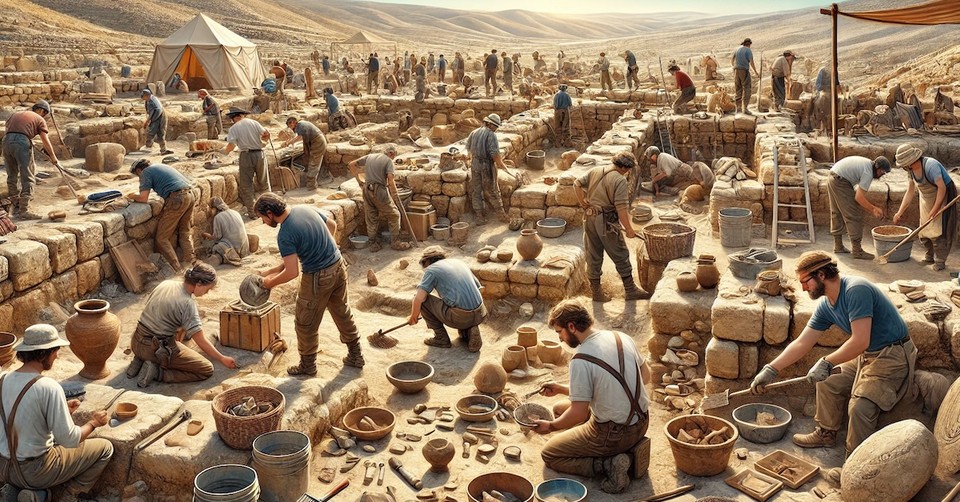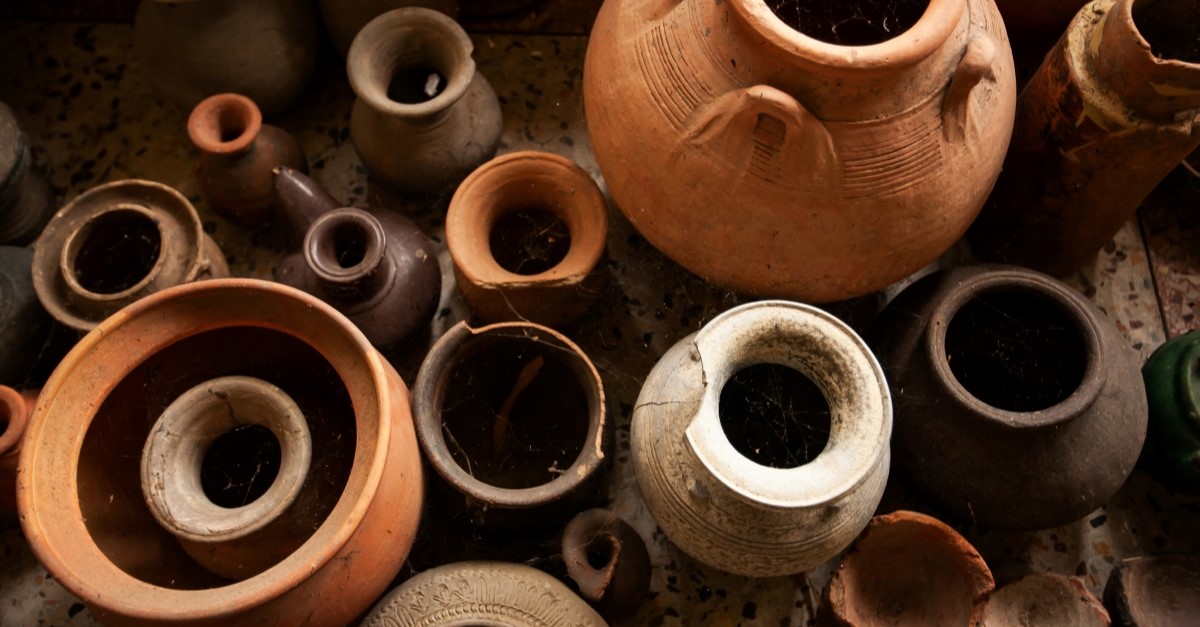How Does Bible Archeology Help Confirm Our Faith?

"But Jesus answered, "I tell you, if my followers didn't say them, these stones would shout them." Luke 19:40 ERV
Archeology is everywhere in Israel, and Jerusalem is considered the most excavated city in the world. It truly seems that the rocks are crying out to confirm the history in the Bible and faith in Him. Standing at the Western wall (also called the wailing wall) is the remaining wall of the second Temple, the Temple Jesus entered. It connects us to God and His story.
Throughout Israel foundations of rocks dug up by archeologists are easy to spot. Each pile reveals past cities, synagogues, homes, palaces, and protective walls. They also provide insights into the culture and traditions of the times. Each wall serves as a testimony to the Bible.
Walls
Recent methods have improved carbon dating uses ancient tree rings for a more precise timeline. That led to realizing King Uzziah as indicated in 2 Chronicles 26:9 actually built towers and walls that had been attributed to King Hezekiah. His fortified walls and new weaponry made him powerful. It also reveals that Jerusalem grew much earlier than thought. The earlier walls, set by Solomon, formed the shape of a foot, illustrating that God placed his footprint on Jerusalem.
Some walls are from ancient times, including the first temple era, some are from the second temple period, and others were built by Romans when they ruled the land. They agree with the Bible and historic documents. Every old wall dug up connects us to its story and people.
Jewish Traditions
One way people recognize a Jewish town is the presence of a synagogue and a Jewish Mikveh, a purification bath built in the ground where freshwater must flow naturally in and out. The Mikveh is a reminder of the importance of being holy. They are generally found close to the synagogue so people could be cleansed before entering.
In Luke 2, Mary followed the purification laws before presenting Jesus in the Temple. In John 2, Jesus used stone jars meant for purification to turn water into wine. Following the wedding, Jesus cleansed the Temple. Standing by a Mikvah is a reminder that Jesus was more interested in cleansing the heart than the body.
Plants, Trees, and Seeds in Israel
Neot Kedumim nature reserve grows the plants found in the Bible. There are even remains of a winepress near a cave where wine could be stored, and grapes grow nearby. Naturalists there study the Scriptures to find the plants described in them and share the species grown and their importance to faith. Learning how to identify various trees makes it easy to spot them all over Israel, especially the olive and carob trees.
In Israel, ancient seeds have been discovered in jars at archeological digs and planted. They sprouted and restored some ancient varieties of wheat and date palm trees. The most productive date palm tree was lost at one point and is now growing again, thanks to one find.
Cooking and Meals

Grinding stones and ovens help us understand daily life in past times. Findings at Tel Halif identified with Rimmon in the time of Joshua reveal organized homes with ovens and grinding stones in their own grouping. Their regular activities would have included grinding grain and making bread. It's no surprise that God used bread as part of covenant relationships with His people. Herod's storerooms in Caesarea were large and filled with jars of supplies including grain as he built the place to be safe in case of a long siege.
Two mosaics uncovered by archeologists depict the multiplication of the loaves and fish miracles of Jesus. Two locations are candidates for where Jesus multiplied, but then bread that he did that in two different locations. One is Tabgha, west of Capernaum. The other is Hippo-Sussita. The mosaics were from floors of Byzantine churches in the fourth century, when people thought they knew the locations. The images of the bread, fish, and full baskets highlight the miracles.
Even today in Israelis enjoy many types of bread. Many passages of scripture relate to bread and grinding grain. Overlooking the area the excavated and restored Byzantine tile floor in the area it's easy to envision a huge crowd and realize they understood the significance of so much bread being provided.
Capernaum
Towns that have been excavated connect us with the past culture, especially ones where Jesus walked along the Sea of Galilee like Capernaum with lots of archeology including homes, a synagogue where Jesus may have preached. There's a second or third century Roman bath house, and then evidence of an earthquake that destroyed the town. The area of the Sermon on the Mount lies about three miles southwest of Capernaum. Standing on the hill one can see how it's a natural amphitheater where a large crowd could hear Jesus. It's beautiful, calm, and a place where one can imagine hearing uplifting words about being blessed.
Other findings in Capernaum, including fishing hooks and weights, reflect the town's industry and remind us that Jesus called us to be fishers of men and used ordinary people.
Synagogue at Magdala
On the western side of the Sea of Galilee north of Tiberias, archeologists found a synagogue dating to the first century in a town believed to be Magdala. The Greek name for the town is Taricheae and is mentioned by historians Pliny the Elder, Josephus, and other classic authors. Workers also uncovered what had been a thriving fish market with stone-lined tanks filled with fish.
In the center of the main room, archeologists discovered a small stone table called the Magdala stone, with legs covered with carvings of Jewish symbols. It may have been used to support the Torah scrolls. The designs include one of the earliest images of the seven ranch Menorah, jars, rosettes, and possibly the Jerusalem temple. There are six clusters of hearts that some believe to be the bread of the presence, with each heart shape being two loaves reflecting the way the bread was offered on the showbread table. The symbols affirm the importance of faith the Jews.
In Matthew 15:39, Jesus travels toward Magdala where the Pharisees and Sadducees questioned him to try and test Jesus. He refused to be tested. At Magdala, with a beautiful synagogue where Jesus may have talked, we are reminded that Jesus continued to reach out to the Jews, God's chosen people.
El-Araj Possibly Bethsaida
Going to an excavation site in Israel opens our minds to viewing scriptures differently. We begin to see how people lived at various times and how that impacted their choices and relationship. with God. The sights and sounds bring the Bible to life with a message to the hearts of those who listened and still read the words. Findings from the first-century layer indicate that it was primarily a Jewish town. Another layer reveals the Roman occupation, and a Byzantine church in another layer reveals the presence of Byzantines around the 4th century AD.
Sometimes the smallest find can be the most revealing. Avian is delighted in the discovery of an ink well. That changes the perspective of Bethsaida being a small fishing community and Peter being born there could not have written a book since he came from an illiterate community. It shows at least some people had the skills to read and write.
Qumran and the Dead Sea

Photo Credit: Image created using DALL.E 2024 AI technology and subsequently edited and reviewed by our editorial team.
The Dead Sea, at the southern end of the Jordan River is cited in the Bible as borders of the Promised Land. Its names include the Salt Sea, the Sea of Arabah (meaning wasteland or barren), and the Eastern Sea. It's one of the saltiest and the most mineral-rich bodies of water found in the world. Sodom and Gomorrah are believed to be in that region. Ezekiel spoke a prophecy that this sea would be transformed into fresh water. The prophet Zechariah echoed that message.
Different sects of Jews lived in caves near the Dead Sea including the Essenes. What made that area famous were the Dead Sea scrolls, written between 150 BC and 70 AD, which were discovered in pottery jars in 1947 in a cave near the Dead Sea. Since then more scrolls have been discovered in other caves. These are the largest collection of texts from the Second Temple Period, discovered in eleven caves.
Cave number one, a black hole high up in what appears to be a perilous climb, lies in the midst of limestone cliffs. It's amazing to see how the arid dessert and jars preserved them for centuries. It's a testimony to how God has preserved His Word.
Tower of David
Held in the beautiful setting of the impressive Tower of David near the Jaffa gate, a light and sound show projected on the citadel's walls celebrates the history of David and his battles. Built after the time of King David, viewers see the city being built, armies fighting, and the grandeur of David's reign. It's called The Night Spectacular and ends with Psalm 122 prayer for the peace of Jerusalem.
The Tower of David, or Citadel, is a museum that dates to the Mamluk and Ottoman periods with parts of original walls and foundations from 2500 years ago that the Hasmonaeans (Maccabees) laid. Throughout the centuries conquerors either destroyed or rebuilt the citadel. In 1310 the Mamluk sultan rebuilt it. Then between 1527 and 1541 the Ottoman sultan expanded the citadel.
The museum contains important archeological artifacts dating back more than 2500 years. Watching the show brings to life the heroic deeds of King David and the history of King David.
Traveling to Israel
It's great to travel to Israel, but if you cannot go, it's still great to read the accounts and view photos or videos of such scenes. With newer technology, the finds can be transformed to show us how they looked originally. That provides us with more context as we read the Bible, allowing us to envision the events more easily.
Israel has few tourists currently and thus no lines due to so much reporting about Hamas in the Gaza area and the Israeli hostages. This includes much false information repeated. Israel is quite safe with the only area of contention far north in Gaza. Soldiers are deployed throughout Israel to add protection for citizens and visitors. The Jews and Arabs throughout Israel get along fine as do the tourists. This makes it the best time to travel to the Holy Land.
Photo Credit: Image created using DALL.E 2024 AI technology and subsequently edited and reviewed by our editorial team.
Karen Whiting is a mom, author, international speaker, writing coach, and former television host who loves sharing ideas to strengthen families. She has written Growing a Mother’s Heart: Devotions of Faith, Hope, and Love from Mothers Past, Present, and Future and 52 Weekly Devotions for Family Prayer, which includes a different way to pray each week plus stories and activities to explore questions children ask about prayer. Her newest book, Growing a Joyful Heart co-authored with Pam Farrel, shares stories that show how to have inner joy, more joy in relationships, choose joy in all circumstances, and become a joy-giver. She loves adventure including camel riding, scuba diving, treetop courses, and white water rafting plus time at home crafting and baking.
Originally published June 25, 2024.





